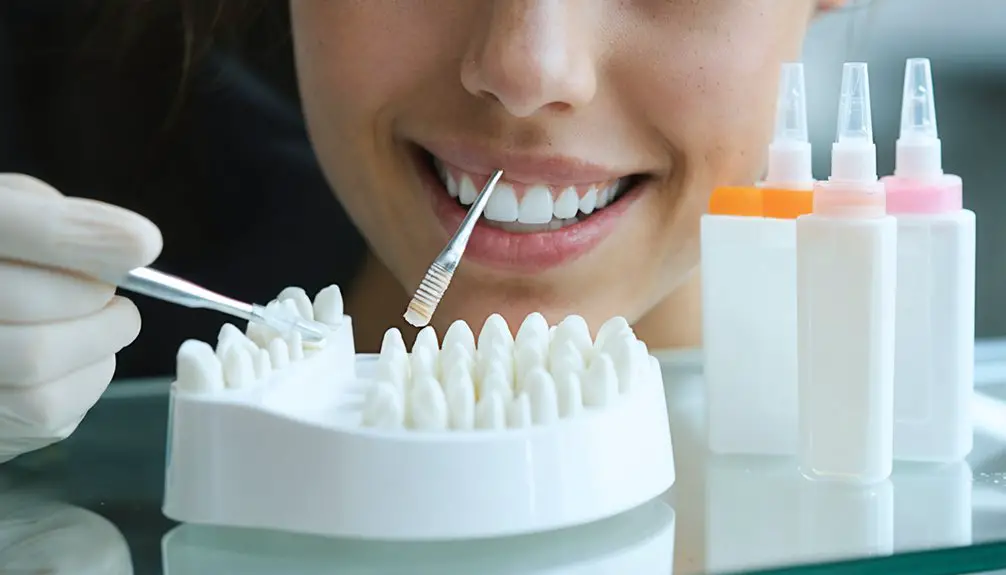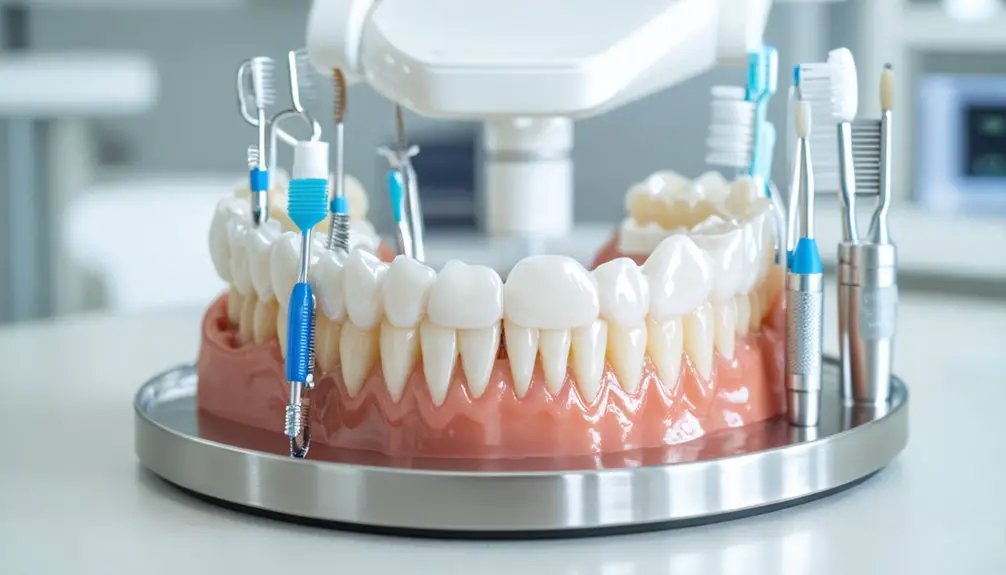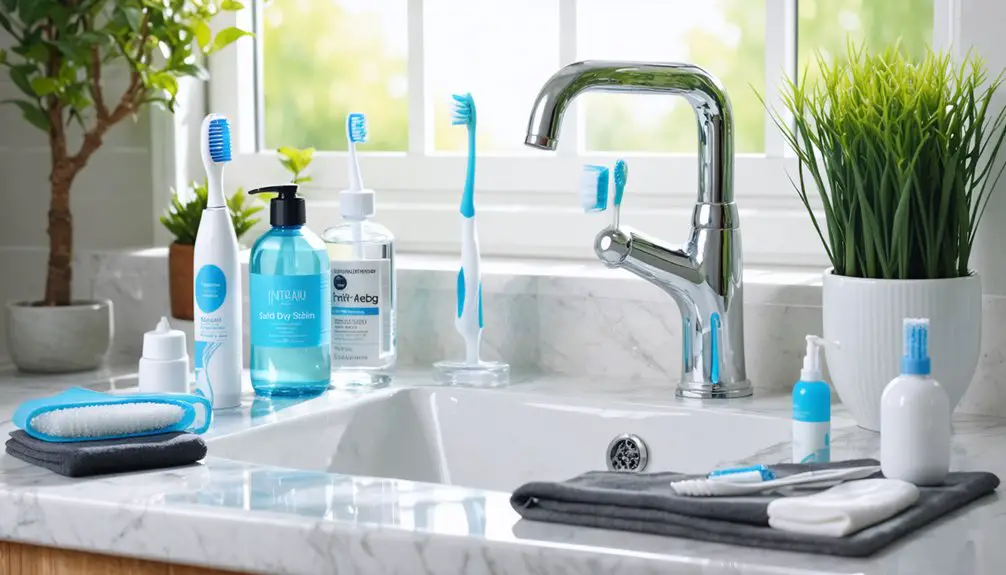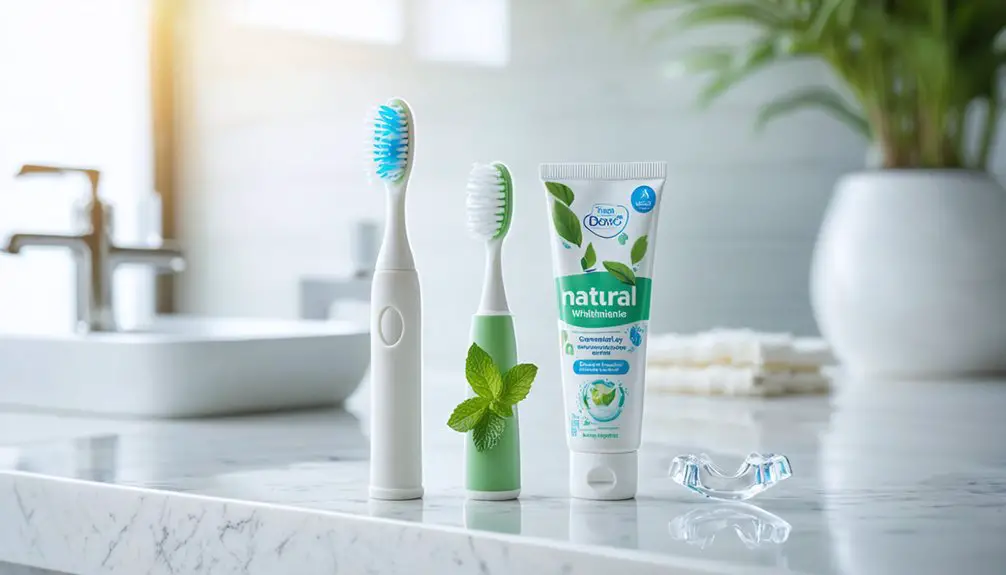To prevent gum irritation during teeth whitening, you’ll need to start with a professional dental assessment to identify potential issues. Choose whitening products with lower peroxide concentrations (<10% carbamide or <3% hydrogen peroxide) and guarantee custom-fitted trays that don’t leak gel onto your gums. Conduct a 24-hour spot test before full treatment, and maintain proper application techniques with barrier gels. Following these protective measures, along with expert guidance, will help safeguard your gum health during the whitening process.
Key Takeaways
- Use custom-fitted whitening trays that properly cover teeth without touching gums to prevent gel leakage and irritation.
- Choose whitening products with lower peroxide concentrations (under 6%) to minimize the risk of chemical burns and inflammation.
- Apply protective barrier gel to gums before whitening treatment to create a shield against bleaching agents.
- Perform a 24-hour spot test on a small area to identify potential sensitivities before full treatment.
- Follow application instructions precisely, using only recommended amounts of gel to avoid overflow onto gum tissue.
Understanding the Causes of Whitening-Related Gum Sensitivity
While teeth whitening has become increasingly popular for achieving a brighter smile, it’s essential to understand why gum sensitivity occurs during the process. The primary culprits are hydrogen peroxide and carbamide peroxide, which can cause chemical burns and inflammation when they contact your gums.
Teeth whitening’s growing popularity comes with risks, as peroxide-based bleaching agents can irritate gums and trigger painful sensitivity.
These bleaching agents penetrate your tooth enamel, making it more permeable and potentially exposing sensitive nerve endings in the dentin. Most patients experience short-term sensitivity that typically resolves within a few days after treatment.
Your risk of experiencing nerve inflammation increases with higher peroxide concentrations and prolonged exposure to whitening gels. If you have pre-existing conditions like gum recession, cavities, or naturally thin enamel, you’ll be more susceptible to irritation. Professional supervision is crucial to ensure the safety and effectiveness of any whitening procedure.
Additionally, poorly fitting whitening trays can leak gel onto your gums, causing direct tissue damage and intensifying sensitivity through uneven application.
Essential Safety Measures Before Starting Treatment
Before starting any teeth whitening treatment, you’ll need a thorough dental checkup to guarantee your teeth and gums are healthy enough for the procedure.
Your dentist should examine you for untreated cavities, gum disease, or worn enamel that could increase sensitivity during whitening.
Professional guidance from a dental consultation helps ensure both safety and optimal results for your whitening treatment.
Once cleared by your dentist, perform a spot-test with your chosen ADA-approved whitening product on a small area to check for adverse reactions before proceeding with full application. Carefully read all instructions on product packaging to ensure proper application and minimize potential risks.
Professional Dental Assessment First
Since teeth whitening treatments can affect oral tissues differently for each person, a professional dental assessment serves as your essential first step toward safe and effective treatment.
Your dentist will conduct a thorough oral health evaluation to identify any existing dental issues that could interfere with whitening effectiveness or cause complications.
During this assessment, you’ll receive a customized treatment plan based on factors like tooth sensitivity, gum health, and the type of staining you have.
A custom-fit tray crafted from your dental impressions ensures even gel distribution for optimal whitening results.
If your dentist discovers conditions such as cavities or gum disease, they’ll recommend addressing these issues before proceeding with whitening. Scheduling a consultation is easy by calling Ashby Dental at their Berkeley office.
They’ll also determine the appropriate concentration of bleaching agents for your specific needs and create custom-fit trays to protect your gums during treatment, ensuring ideal results while minimizing risks.
Spot-Test Before Full Application
To guarantee a safe teeth whitening experience, conducting a spot test is a vital preliminary step that can prevent widespread adverse reactions.
Begin by applying a small amount of the whitening product to one tooth’s inner surface or adjacent gum area, following the manufacturer’s recommended duration.
Monitor the test area for 24 hours, watching for signs of redness, swelling, or discomfort. This patch testing helps identify potential ingredient sensitivity to common whitening agents like hydrogen peroxide or carbamide peroxide. ADA-approved products provide additional assurance of safety and effectiveness during spot testing.
If you notice any adverse reactions, consider using a lower concentration or different formula. Those with pre-existing conditions like gum disease or sensitive teeth should pay particular attention to their spot test results, as they’re more susceptible to irritation. Professional dentists recommend in-office whitening treatments for patients with particularly sensitive teeth to ensure safer and more effective results.
Only proceed with full treatment if you observe no negative reactions during this vital safety check.
Choosing the Right Whitening Products for Sensitive Gums
If you’re dealing with sensitive gums, you’ll want to contemplate both professional treatments under dental supervision and gentler at-home options like Crest 3D White Whitestrips Gentle Routine.
Look for products containing lower peroxide concentrations (typically under 6%) to minimize the risk of gum irritation while still achieving whitening results. Taking breaks between sessions helps reduce gum sensitivity and allows tissues to recover. Natural alternatives like baking soda provide a mild abrasive option for surface stains.
Key desensitizing ingredients like fluoride and specialized gels can provide additional protection for your gums during the whitening process, whether you choose professional or at-home treatments.
Professional Vs Home Options
When choosing between professional and at-home teeth whitening options, understanding the key differences in peroxide concentrations and application methods becomes vital for those with sensitive gums.
Professional techniques use higher peroxide concentrations (25-40%) under controlled conditions, while home products contain lower levels for gradual results.
Here’s what makes professional whitening safer for sensitive gums:
- Dental supervision guarantees precise application and minimizes gum contact
- Pre-treatment assessment identifies potential sensitivity issues
- Immediate access to desensitizing agents during treatment
- Controlled exposure time reduces risk of irritation
While home products offer convenience and gentler formulations, they require longer treatment periods and careful application to prevent gum irritation.
Consider your sensitivity level, desired results, and budget when deciding between professional supervision or at-home care.
Lower Peroxide Formulations Available
Selecting the right peroxide concentration proves essential for individuals with sensitive gums seeking teeth whitening solutions. You’ll find lower peroxide options specifically designed to minimize irritation while still delivering results.
Products like Crest 3D White Whitestrips Gentle Routine contain reduced concentrations of peroxide (<10% carbamide or <3% hydrogen peroxide) to protect sensitive tissues.
For even gentler formulations, consider non-peroxide alternatives that incorporate natural ingredients like aloe vera, coconut oil, or baking soda. The Oral Essentials Lumineux Whitening Kit offers a peroxide-free approach.
Many sensitive-focused products also include protective ingredients like potassium nitrate and fluoride to strengthen enamel and reduce discomfort. While these lower-concentration options may require longer treatment periods, they’ll help you achieve whiter teeth with minimal gum irritation.
Desensitizing Ingredients Matter Most
For individuals with sensitive gums, desensitizing ingredients serve as the cornerstone of effective teeth whitening products. When selecting whitening treatments, prioritize formulations containing both potassium nitrate and fluoride for ideal protection. These dual-action ingredients work together to block nerve pain signals and strengthen your enamel.
Key features of effective desensitizing gels include:
- Potassium nitrate (3%) to interrupt nerve sensitivity
- Fluoride ions (0.11-2%) for enamel reinforcement
- Low-viscosity formulations for improved application
- ADA-endorsed concentrations for safety
Apply desensitizing gels via custom trays for targeted delivery, using small amounts to prevent overflow.
You’ll achieve the best results through consistent use, complemented by sensitivity-relief toothpaste for long-term comfort and protection of your patients’ enamel health.
Professional vs. At-Home Whitening: Which Is Safer?
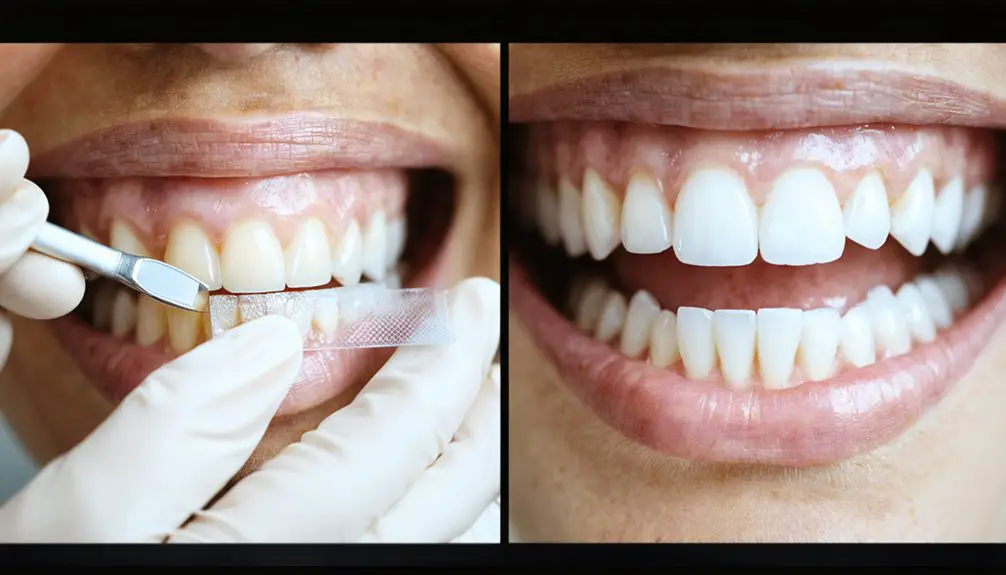
Making an informed choice between professional and at-home teeth whitening hinges primarily on safety considerations.
Professional treatments offer significant benefits, including dentist supervision, protective barriers for your gums, and precise application of higher-strength peroxide (25-40%). Your dentist can monitor and adjust the treatment in real-time, minimizing sensitivity and irritation risks.
Professional teeth whitening combines expert supervision with stronger peroxide solutions, ensuring both optimal safety and superior results under careful monitoring.
At-home risks increase due to unsupervised use of lower-strength peroxide (3-10%), which requires longer exposure times. You’re more likely to experience uneven whitening, chemical burns, or gum irritation from improper application.
While at-home kits can be effective when used correctly, they depend heavily on your ability to follow instructions carefully. For peak safety, especially if you have pre-existing dental conditions, professional whitening provides better protection and more predictable results.
Step-by-Step Guide to Protective Application Techniques
To achieve ideal gum protection during teeth whitening, you’ll need to make sure your custom trays fit snugly against your teeth without pressing into your gum line.
When applying the whitening gel, place small dots in the front surface of each tooth compartment in the tray, using only enough to cover the visible tooth surfaces without overflow.
Before inserting the tray, verify that your gums are completely dry and protected with a barrier gel, then carefully position the tray to avoid pushing excess gel onto your gum tissue.
Proper Tray Fitting Tips
Proper tray fitting serves as the cornerstone of effective teeth whitening treatment, requiring careful attention to detail during the initial setup process. Your customized trays should fit snugly against your teeth while avoiding contact with your gums.
Before applying any whitening gel, conduct a thorough fit testing session to guarantee ideal comfort and effectiveness.
Follow these essential steps for proper tray customization:
- Submerge your tray briefly in hot water to enhance moldability.
- Test the fit without gel first to identify any pressure points or air pockets.
- Trim excess material that extends onto the gum line.
- Verify the tray creates a tight seal around your teeth.
Remember to schedule regular follow-up appointments with your dentist to monitor the fit and make necessary adjustments, guaranteeing your whitening treatment remains both comfortable and effective.
Safe Gel Application Methods
Successful teeth whitening depends on precise gel application techniques that protect your gums while maximizing whitening effectiveness.
Apply a rice-sized drop of gel per tooth compartment in your whitening tray, focusing only on the visible enamel surfaces. Before insertion, dry your teeth with a clean cloth to improve gel adherence and reduce spreading.
To prevent gum irritation, place gel directly into tray compartments rather than onto teeth. Press trays firmly but gently, avoiding excessive pressure that could squeeze gel onto gums.
Use cotton swabs to remove any excess gel from tray edges before inserting. Don’t bite down during wear time, as this can force gel onto sensitive gum tissue.
For gel pens or brushes, apply a thin layer equivalent to half a pea-sized amount per arch.
Natural Remedies for Soothing Irritated Gums
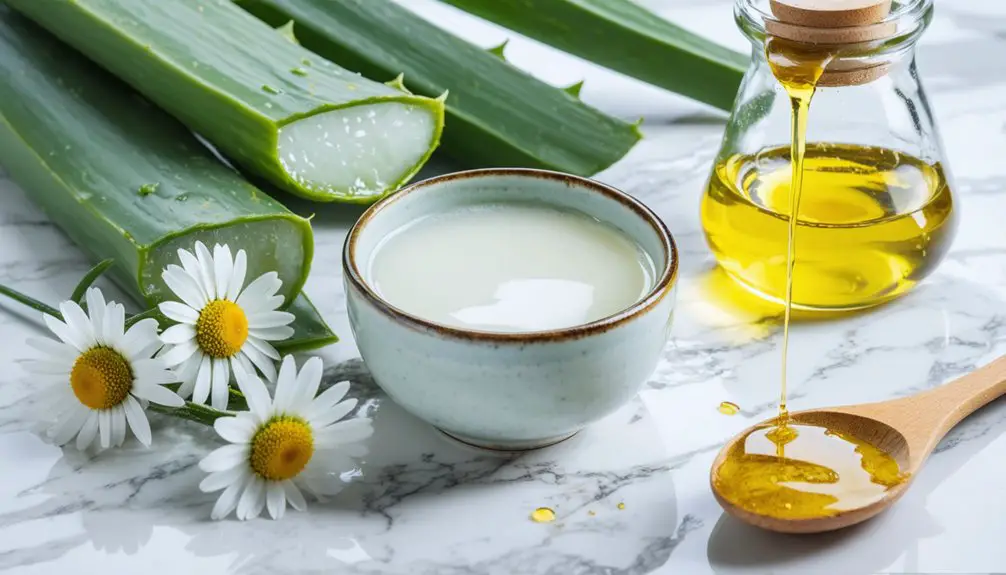
When gum irritation occurs during teeth whitening, several natural remedies can effectively soothe discomfort and promote healing. You’ll find relief using salt water rinses, tea bag compresses, herbal pastes, aloe vera gel, or coconut oil pulling methods. For immediate care, mix one teaspoon of salt with warm water and rinse for 30 seconds.
For targeted treatment, consider these proven applications:
- Apply cooled black, green, or chamomile tea bags directly to affected areas.
- Create a paste using turmeric or clove powder with warm water.
- Gently dab pure aloe vera gel onto irritated gums.
- Practice oil pulling with coconut oil for 15-20 minutes daily.
These natural solutions help reduce inflammation, provide pain relief, and support tissue healing without introducing harsh chemicals that might further aggravate sensitive gums.
Best Practices for Custom Tray Usage
While natural remedies help soothe irritated gums, preventing irritation through correct custom tray usage offers the most effective approach to comfortable teeth whitening.
Your custom tray customization should guarantee a precise fit over your teeth, with proper adaptations for any misalignments or spacing issues.
Apply whitening gel using careful gel application precision – place small dots in each tooth compartment rather than spreading it across the surface.
Don’t overfill, as excess gel can leak onto your gums. Keep your trays clean and dry before each use, and store the gel syringe in your refrigerator to maintain its effectiveness.
Follow your prescribed wear schedule, typically overnight, but don’t exceed recommended duration. If you notice any gum sensitivity, take a break between whitening cycles and consult your dental professional for adjustments to your treatment plan.
Recovery Tips After Whitening Sessions
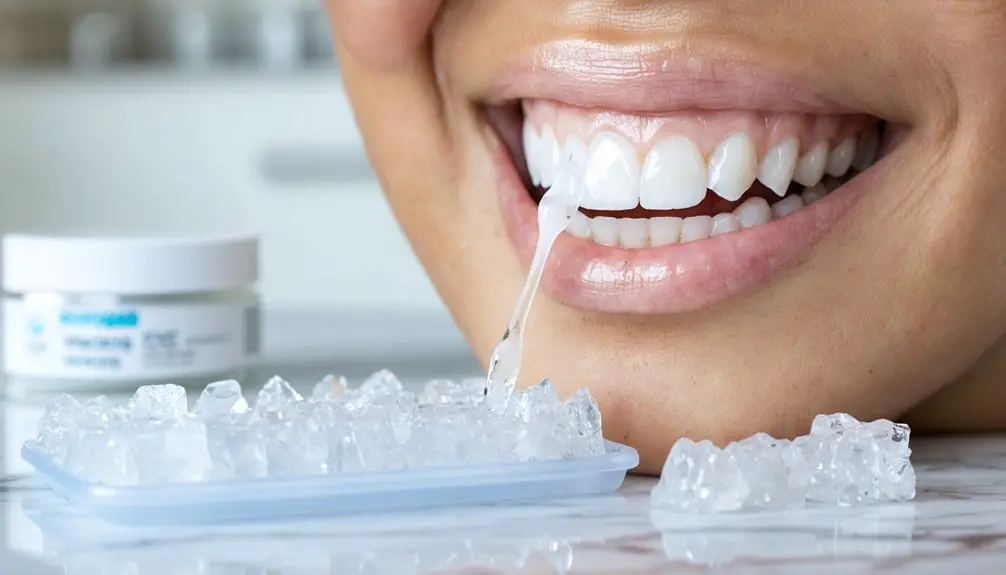
To minimize discomfort after teeth whitening treatments, you’ll need to implement specific recovery measures that promote healing and reduce sensitivity. Focus on gentle oral hygiene practices and maintain proper post whitening hydration to support your gums’ recovery process.
Taking care of your teeth after whitening requires gentle practices and proper hydration to ensure optimal healing and minimal discomfort.
For immediate relief and ideal healing, follow these essential steps:
- Alternate warm and cold compresses on your cheeks to reduce inflammation.
- Rinse with saltwater solution twice daily (½ teaspoon salt in warm water).
- Apply pure aloe vera gel to soothe irritated gum tissue.
- Switch to soft-bristled toothbrushes and gentle brushing techniques.
Stick to soft, bland foods while avoiding spicy, acidic, or crunchy items. Use non-alcoholic mouthwashes and postpone flossing near sensitive areas until irritation subsides.
If symptoms persist beyond a few days, schedule a follow-up with your dentist.
Warning Signs That Require Immediate Action
Although teeth whitening procedures are generally safe, recognizing warning signs that demand swift intervention can prevent serious complications.
Stop your whitening treatment immediately if you notice unbearable pain, severe burning sensations, or white patches on your gums, as these indicate chemical burns.
Watch for blisters, sores, or persistent inflammation lasting beyond 48 hours, which signal tissue damage requiring professional care.
Monitor your gum health closely during the whitening duration.
If you experience fever, pus discharge, or unusual numbness, seek urgent dental evaluation.
Pay attention to sudden gum recession or detachment from teeth.
When whitening gel overflows onto gums or you notice continuous bleeding, these warnings suggest improper application that needs correction to prevent lasting damage.
Long-Term Strategies for Maintaining White Teeth Without Gum Damage
Maintaining your teeth’s whiteness without compromising gum health requires a thorough, long-term approach that combines proper oral hygiene, strategic dietary choices, and controlled use of whitening products.
For effective long-term maintenance, incorporate these essential practices into your routine:
- Brush twice daily with gentle whitening toothpaste and floss consistently to prevent stain accumulation.
- Use a straw when consuming staining beverages and rinse with water afterward.
- Schedule professional cleanings every six months for safe stain removal.
- Limit whitening frequency to recommended intervals, typically once every 6-12 months.
Between professional treatments, focus on preventive measures rather than frequent whitening applications.
Use antimicrobial, alcohol-free mouthwash daily, and choose whitening products specifically formulated to minimize gum sensitivity.
When using at-home treatments, always follow product instructions precisely to protect your gum tissue.
Frequently Asked Questions
Can I Drink Coffee Through a Straw While Whitening to Prevent Staining?
Don’t drink coffee during whitening, even with a straw. After 48 hours post-treatment, straw benefits include reduced staining. Until then, consider coffee alternatives like caffeine-free herbal teas or water.
Will Previous Dental Work Affect How My Teeth Respond to Whitening Treatments?
Like a chameleon’s limitations, your dental work won’t change color with whitening. You’ll notice uneven results since natural teeth will brighten while dental crowns stay the same, potentially causing teeth sensitivity.
Is It Safe to Whiten Teeth While Pregnant or Breastfeeding?
You shouldn’t whiten teeth during pregnancy due to safety concerns. While it’s likely safer during breastfeeding, consult your dentist first. Consider non-bleaching alternatives or wait until after pregnancy and nursing.
How Long Should I Wait After a Dental Cleaning to Start Whitening?
You can safely begin whitening immediately after your dental cleaning for best results, as your teeth are free of plaque. If you’re experiencing gum sensitivity, wait 2-3 days before starting your whitening timeline.
Can Certain Medications Increase Sensitivity During Teeth Whitening Procedures?
Like a knight’s shield, certain medication types can heighten your sensitivity levels during whitening. NSAIDs, antibiotics, and dry mouth medications may increase discomfort, so tell your dentist about all drugs you’re taking.
References
- https://www.drbobsdentalcare.com/can-teeth-whitening-damage-gums/
- https://www.nhsmilesbydesign.com/blog/should-teeth-be-whitened-to-reduce-the-risk-of-gum-irritation/
- https://dentalgroupoflubbock.com/why-teeth-whitening-can-trigger-rashes-on-lips-gums/
- https://valleycreekdentalcare.com/blog/preventing-gum-irritation-teeth-whitening-expert-tips-for-a-safe-experience
- https://shodhandentistry.com/how-to-treat-gums-burned-by-teeth-whitening/
- https://www.goodrx.com/conditions/dental-care/sensitive-teeth-after-whitening
- https://111dental.com/can-teeth-whitening-damage-gums-how-to-whiten-safely-in-bixby-ok/
- https://www.scottgreenhalghdds.com/blog/10-tips-for-dealing-with-sensitivity-after-teeth-whitening
- https://tooth-doctor.com/severe-tooth-sensitivity-after-teeth-whitening/
- https://www.bocaratoncosmeticdentist.com/blog/pain-after-teeth-whitening/
